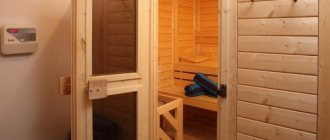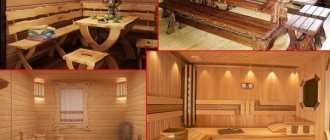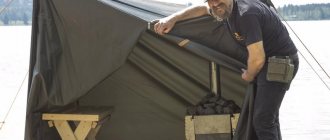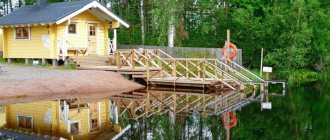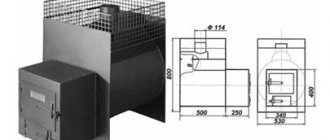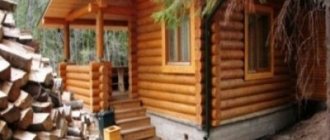A tent sauna is the simplest of the possible sauna options. A camp bathhouse will allow you to relax during a long hunt or fishing, on a hike or during a jeep safari. It can also be installed on a summer cottage (if a “stationary” bathhouse is being built or is still at the design stage).
A camping sauna tent is an excellent option for relaxing in the country, fishing or hunting
There are many options for making a sauna-paltaki. You can buy a ready-made tent with or without a stove, or you can build everything entirely from scrap materials. It is not recommended to use regular camping tents. Firstly, such fabrics are not intended for high temperatures and you will soon have to buy a new tent, and secondly, when heated they can emit harmful substances. Well, they are not designed for use in such aggressive conditions. But an old canvas tent can be used as a bathhouse: it holds heat well and there are no harmful fumes. If you don't have a tarp, appropriately sized plastic sheeting will do.
Sauna tent made of polyethylene film
DIY camp sauna
A mobile bathhouse tent is constructed from a frame covered with film, awning or tarpaulin. A stove is installed inside. There are 2 options for organizing a bathhouse: assemble a structure from available materials or install a factory-made tent.
In the first case, the frame of the camping bathhouse is optimally folded from thin metal tubes, but it will have to be transported to the resting place. In nature, a similar skeleton of a structure is assembled from long, strong poles. Cobblestones are used to lay the stove.
The second option for a camp bath is a ready-made, factory-made tent. She will have to be transported to her vacation spot by car. Plus, a metal stove is included with the tent. It is small, but it has weight, and it is difficult to carry such a load manually.
Advice! When using a tent, it is optimal to give preference to a Soviet-style product.
The choice is explained by the fact that in such models a tarpaulin serves as cover for the frame. The material retains heat and moisture and does not emit harmful fumes when heated.
Features of the design of a camp bath
The main requirement for such structures is that the camp sauna tent must be light, safe, and quickly disassembled and assembled.
The best frame for a bathhouse is considered to be a frame made of aluminum tubes. When disassembled, it is easy to carry even by hand. The assembled frame is durable and fireproof. If the skeleton of the tent is made from wooden poles, then the best material is considered to be long, thin trunks of young trees. The poles should not be taken dry, as they are fragile and more susceptible to ignition from the stove.
The best covering material for a bathhouse is Soviet-style tarpaulin, but it is heavy, expensive and cannot be purchased everywhere. An ordinary film will serve as a primitive shelter. For a tent designed for 5 people, you will need a piece measuring 6x6 m. The disadvantage of the film is that it quickly burns out when hit by a spark from the stove, but it is easy to carry with you on a hike.
Any sauna tent must be equipped with a stove. There are 2 options to choose from:
- The stove-heater is built on a resting place from large cobblestones. The design resembles a well with a closed top. A window is left on the side for placing firewood in the firebox.
- The portable sauna stove is welded from metal. The design resembles a potbelly stove. There is a platform on top of the stove where you can heat water and heat stones to create a steam room.
The camping stove can be folded inside or outside the tent. The first option is called “black”, since there is smoke inside the bath along with the steam. The second option is called “in white”. Smoke from the stove does not penetrate into the tent. The stones are heated outside the bathhouse and brought inside while hot.
Important Terms
A portable sauna tent cannot be installed anywhere. It is optimal to choose a site with suitable conditions:
- Availability of water. In camping conditions, a suitable option for a bathhouse is the bank of any pond or river.
- Stones. If there is no metal portable stove, it will have to be stacked with cobblestones. There should be stones nearby, but not layered, but solid. Otherwise, the cobblestones will crack due to heating. Flying fragments can injure a person. The optimal dimensions of a cobblestone are from 10 to 12 cm. Small stones cool quickly, while large stones take a long time to warm up over a fire. The optimal shape of the cobblestones is slightly flattened and elongated. It is difficult to build a stove out of round stones, as they will roll off.
- Young trees. If you don’t have the frame with you, it is collected from long poles 3-4 cm thick. The material is looked for in the nearest forest or planting.
- Firewood. The stove in the camp sauna is heated for about 3 hours. Firewood requires dead wood. Trees are selected with a trunk thickness of 10-15 cm.
On a hike, it’s not always possible to find a place for a bathhouse with all the conditions, but you need to try to find something in between. First of all, a reservoir is in demand. Stones, firewood, and poles can be searched for and brought by hand.
Bathhouse tents from manufacturers
Specialized travel stores offer outdoor enthusiasts portable bathhouses in the form of kits consisting of the following elements:
- tent;
- bake;
- bench;
- ladles.
Some manufacturers sell benches and buckets separately, believing that they may not always be in demand. The stoves offered in kits often resemble ordinary potbelly stoves, so if tourists have something similar, it is not profitable to purchase a kit.
Tents from different manufacturers differ in the quality of the material that can be presented:
- polyethylene;
- PVC film;
- tarpaulin
A camping mobile sauna should always have a particularly strong frame. In some kits it is made of aluminum profile, in others only metal pegs are offered, and for load-bearing supports it is recommended to use trunks of dried trees or shrubs, which are abundant in the forest.
The mobile sauna tent has a fire-resistant coating in the place intended for installing the stove, this is a fundamental difference from conventional tent products.
Hiking models, which are expensive, are equipped with forced ventilation and have a special windproof belt, which creates comfortable conditions in the interior that are most reminiscent of the environment in stationary baths.
True, such a bathhouse is not a completely portable model; it is good for motorists, lovers of hunting or spending time in the country; not very convenient for conquerors of mountain trails and river cascades.
DIY manufacturing steps
A tent bathhouse is set up according to almost the same principle, regardless of the available material. The difference is the location of the stove.
Making a camp sauna “white-style”
“The white way” is to set up a sauna in a tent with your own hands without a stove. It is built outside the steam room. Only hot stones are brought inside the tent. The advantage of this method is the absence of smoke. The downside is that the camp bath takes a long time to warm up and cools down quickly. It is optimal to build a small tent so that there is enough space only for the necessary procedures. A large camping steam room will take a long time to warm up, you will need a lot of stones, and in cold weather this is almost impossible to achieve.
Due to the absence of a stove inside the tent, film can be used as a covering material. The frame in the traveling version is most often made of poles. You will need 8 poles more than 1 m long. The poles are tied together with wire or tape. You should get a cube or parallelepiped.
Advice! For a group holiday, it is better to build a bathhouse for 4 people and take turns to steam.
For 1-2 people, you can get by with a wigwam-shaped frame. 3 poles are placed at an angle, forming a cone. Before stretching the film, tape all sharp knots on the sticks. The polyethylene sleeve is opened with a knife. The resulting single-layer fabric covers the frame. The film is taped to the poles and secured with clothespins.
2 large sheets of film are left on the entrance side. The doors should overlap so that steam does not escape from the camp bath. Inside they set up a place for hot stones. It is fenced off with sticks 30-50 cm long driven into the ground. The floor of the camp bathhouse is covered with spruce branches. For sitting, you can lay a rug or find a stump.
The stove is installed at a safe distance from the tent. The spark should not reach the film cover. You also can’t move the stove too far away, because you’ll still have to carry hot stones into the tent. After the construction of the stove, the remaining stones are not thrown away. They press the bottom of the tent's film cover to the ground. It is important to place the stones tightly together, otherwise steam will escape from under the unpressed areas.
Making a sauna tent “the black way”
Using the “black” method, a do-it-yourself sauna on a camping trip is installed in the same way. The difference in the design is the location of the stove inside the tent. The frame of a camp bath is tied with willow twigs or vines. The easiest option is to fasten 4 poles about 1.5 m long with tape. If you can find long poles about 3 m, then 2 of them will be enough. The poles are simply bent, tying them with a cross in the center to form a hut shape.
Film can serve as a shelter for a camp bath, but polyethylene is afraid of fire. The stove will have to be folded efficiently in order to protect the film tent as much as possible from sparks.
For a “black-style” camping sauna, it is better to install a collapsible frame made of thin aluminum tubes. It is guaranteed not to ignite in the oven. Instead of film, the tent is covered with a tarpaulin. Durable posts will withstand the shelter even if it is covered with snow or rain accompanied by strong winds.
A quick camp sauna with a stove is organized in a factory-made tent, only with a tarpaulin cover. The frame is assembled from folding arches in a few minutes. For convenience, first a stone stove is laid out in the tent, and then a tarpaulin cover is pulled up.
We build the frame
So, if the stove-heater is located inside the steam room, then the frame is installed around it. Then the four corner posts are driven into the soil and connected at the top along the perimeter with poles. In this way you can make a bathhouse in the shape of a cube or parallelepiped. The choice should be based on the number of people who want to be in the steam room at the same time.
To make the tent in which the steam room will be more stable, you can add supports on the sides, leaving space for the entrance. And to avoid the roof sagging, place several crossbars on top.
Fasten all the poles together with wire, rope or tape. The latter is useful for wrapping sharp corners of the frame, which can damage the film if you use it as a covering material.
Photo from the site pp.vk.me
When you have installed the frame and flooded the sauna, take care of the floor of the steam room. To avoid sitting on the cold ground, lay down travel rugs or place folding chairs. If the size of the bathhouse does not allow it or such props are not available, cover the ground with spruce branches and sprinkle leaves on top.
Next, cover the frame with thermal insulation material.
Do-it-yourself camping sauna stove
The stove-stove for a camp bath is built with your own hands on the spot from large cobblestones. In fact, the design resembles a potbelly stove. First, lay out the firebox in the shape of an unfinished ring, leaving a window for loading firewood. The vault is made as shown in the figure: solid, vaulted or with a lintel. The first scheme is worse due to poor heating of the upper cobblestones, since there is not enough flame to reach them.
All about stones
You will also need a lot of stones - one pass “eats” a bucket of stones. The best option here is large limestone blocks. Stones should be selected carefully, discarding those with chips and impurities. A stone containing foreign fragments may rupture when heated.
Firewood of medium thickness is laid on the ground, and the first layer of stones is placed on it. A fire is built on the stones and, as it burns, firewood is added. Stones are placed on top in another layer.
And so on until the required number of stones are in the fire. The heat and flame of the fire should be maintained for two hours.
The main stages of constructing a bath using improvised means
Experienced travelers quickly erect a sauna tent with a stove. A beginner should follow the steps step by step, following the recommendations. After several training sessions, installing a camp sauna will take no more than an hour.
Selection of location
A suitable site for a camp bath is selected taking into account important conditions. Any source of water, firewood and stones is required. Carrying cobblestones from afar is difficult. The same goes for water. You can bring a couple of buckets, but the pleasure from bathing will be limited. It’s good to stop on the shore of a pond, where you can take a dip after the steam room.
When choosing a site, it is worth examining the soil. The ground must be solid. In soft and loose soil it is impossible to reliably strengthen the tent poles.
Construction of the stove
The most important step is to install a stove for a camp bath using cobblestones found in the vicinity. The simplest heater is built according to the following rules even before covering the tent with a tarpaulin:
- Under the stove, cut off the upper part of the soil with a sharp spatula. The base is laid out in the recess with cobblestones. If there is dry grass nearby, remove it with a spatula to prevent fire.
- Using flattened cobblestones with a size of 200 mm or more, lay out the fireplace. Its height and diameter are approximately 700 mm. A small opening is left for storing firewood in the fireplace. The hearth is covered from above with a large flat stone. You'll be lucky to find a slab-shaped savage. It is convenient to place a bucket of water on a flat stone.
- A fire is lit in the stove of the camp sauna tent 4 hours before swimming. The readiness of the stones will be indicated by their red or white color, which depends on their breed.
The first watering on the stove is done with caution. If the stones do not crack and no fragments fly off from them, the cobblestones are selected correctly.
Frame structure
A collapsible tent has a frame made of tubes. When using a homemade structure, the felled poles are cleared of knots. The most convenient and safest is a two-compartment camping sauna. The frame of the tent is made in such a way that the steam room is slightly removed from the stove.
First, 4 racks are dug in the corners. From above they are connected along the perimeter and crosswise by crossbars. The poles form a strong outline of the tent and prevent the tarpaulin from sagging on the ceiling. Two long poles are placed at an angle to one side of any wall. They are attached to the tent frame from above, and pressed into the ground from below. This creates a second compartment for the stove.
Canopy for camping steam room
For a tent, it is advisable to use a single piece of film or tarpaulin. It should be larger in size than the frame so that the bottom edges can be strengthened well. The canopy is pressed to the ground with cobblestones or earth. The best option is to dig a trench around the frame, lay a canopy, and cover it with soil.
The warm floor inside the tent is made of spruce branches. Lay a rug on top or lay out thin branches with foliage. Birch is ideal.
Adviсe
And finally, I would like to give a few recommendations that may be useful to you when building and using a camp sauna:
- Despite the fact that your new bathhouse is a camping one, the rules for visiting it are the same as in a regular stationary bathhouse. Remember that in order to avoid health problems, you should not take a steam bath in a mobile sauna after a heavy meal or drinking alcoholic beverages.
- When heating stones, you should move away from the fire, as stones under the influence of high temperature can crack, explode and fly into fragments, which can be potentially dangerous.
- If the steam in your sauna rises to the top, it means you still have enough time to steam properly. If, due to the thick steam, the interior of the bathhouse is no longer visible, then the temperature in the steam room drops, and most likely this will be the last time.
- A camp sauna practically does not warm the ground - therefore, the places where people will sit should be covered with oilcloth and rugs.
Expedition along mountain rivers (part 10) | Bath day | 18+ | Mobile sauna Walrus
Tips for using a camp sauna
Using a sauna tent is easy. A few tips will not hurt novice travelers:
- when burning wood in the tent, leave a small open window to ventilate the smoke;
- a bucket of water is placed on the stove to water the heater;
- after heating the stones, the burnt-out heat is removed from the heater, and the tent is tightly closed to avoid heat loss;
- The stones are watered as needed to create a comfortable amount of steam.
Cooling of the stove stones takes about 2 hours. During this time you can comfortably steam. To protect the walls of the tent from fire and people from accidental burns, the stove is fenced with shields made of branches.
How to choose a place for a mobile sauna
The frame is placed on the shore of a suitable body of water - a lake or river. An area with dense, non-flowing soil is suitable; The tent must be secured, otherwise burns and bruises are possible.
See if the parking lot has everything you need: suitable stones, poles for the frame, dead wood for kindling. Sometimes it is not possible to find a site that suits all parameters - you need to act according to the situation. In any case, the tent is set up close to the water, and you can bring stones and firewood.
Nuances of a “savage” bathhouse
It’s quite simple to build a “savage” bathhouse with your own hands, but in nature, even in the forest, some difficulties with construction may arise.
Disadvantages of a polyethylene bath: - weight and volume of the film. Polyethylene film, even carefully folded, takes up half a backpack, it weighs a lot and therefore is not entirely convenient for long hikes; - impracticality of polyethylene. After bath procedures, it is very difficult to dry the cellophane tent and it is difficult to carefully put it back into the backpack; - stones. Not every area has suitable stones for constructing a stove. But they can be purchased in specialized stores. The advantage of purchased stones is that they heat up quickly, but the disadvantage is that they cool quickly, weigh a lot and take up space; - stuff. The probability of finding suitable poles in some areas is reduced to zero; - firewood. In order not to waste time looking for firewood or to avoid the loss of it completely, it is better to take it with you on a hike; — the facade does not have an entirely aesthetic appearance.
When you can’t afford to buy building materials to build a “Russian” bathhouse, you can install such a polyethylene bathhouse in your garden. Construction crews often use such baths. It is better to use beams instead of branches on your site, then the bathhouse will be much stronger. And having bought a professional awning, the facade of the garden bath will look more elegant than with polyethylene. The video shows the use of such a steam room in the wild.
